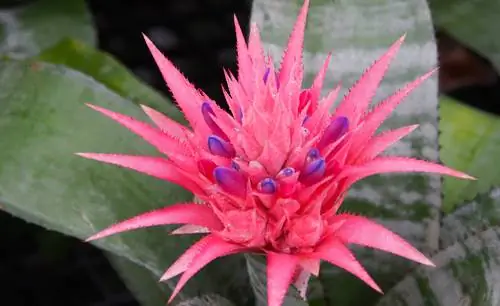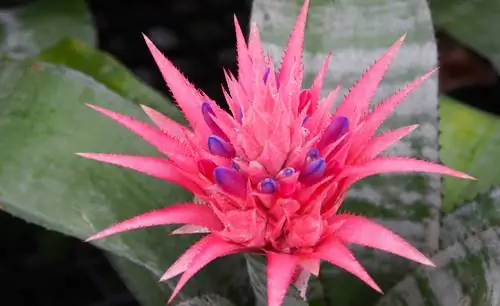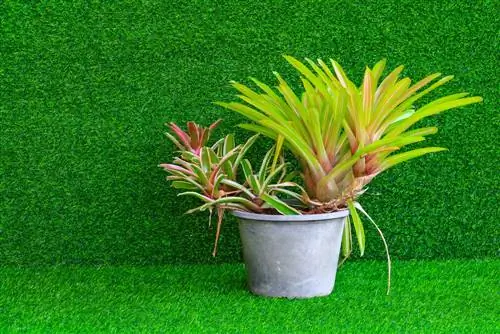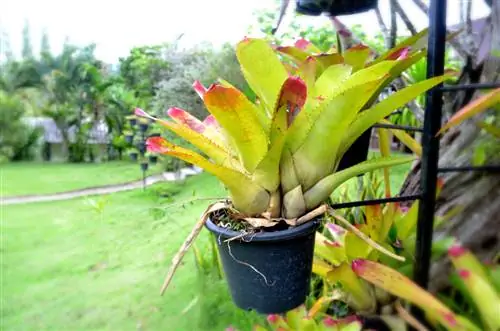- Author admin [email protected].
- Public 2023-12-16 16:46.
- Last modified 2025-01-23 11:21.
The Aechmea, also known as the lance rosette, belongs to the pineapple family, as can easily be seen from the characteristically shaped leaves. The genus, native to the tropical rainforests of Brazil, includes around 180 different species, of which Aechmea fasciata, with its striking bright pink flowers and banded leaves, is mainly cultivated as a houseplant.

What is Aechmea and how do I care for it?
Aechmea is a genus of the pineapple family and includes 180 species that occur mainly in the tropical rainforests of Brazil. Popular houseplant Aechmea fasciata features bright pink flowers and banded leaves. It prefers bright locations and requires moderate watering and occasional fertilization.
Origin and distribution
The lance rosette (bot. Aechmea fasciata) is one of around 180 different species of the genus Aechmea, which in turn belongs to the plant family of the bromeliad and pineapple plants (bot. Bromeliaceae). The popular houseplant is widespread in the tropical and subtropical rainforests of Brazil, but can also be found in other regions of Central and South America. There, the epiphytic plant thrives at altitudes between 700 and 1,300 meters above sea level, far away from the ground and earth, in the large jungle giants. Imported to England as early as 1826, the lance rosette is now one of the most commonly cultivated bromeliads in the living room. This is not only due to their interesting growth and long-lasting flowering, but also to their simplicity.
Appearance and growth
The species Aechmea fasciata is a so-called funnel or cistern bromeliad. These are epiphytic plants (“epiphytes”) whose leaves form a wide rosette. This in turn serves as a funnel in which water collects. Funnel bromeliads are real small biotopes, as they serve as a home for smaller animal species (such as tree frogs) and various aquatic plants. The lance rosette - which owes its German name to the lance-like shape of its leaves, which is also indicated by the ancient Greek word aechme for "lance tip" - grows up to 50 centimeters wide and 60 centimeters high.
By the way, the species is also known to many indoor gardeners as the “silver vase” because the silvery leaves form a funnel reminiscent of a vase.
leaves
The leaf rosette consists of around ten to 20 coarse, hard leaves with spines along the edges. These grow up to 50 centimeters long and up to ten centimeters wide. Typical of Aechmea fasciata is the interesting leaf pattern, which can be banded or marbled. The pattern is caused by silvery-white suction scales (the so-called trichomes) distributed differently on the upper and lower sides of the leaves, which either appear over the entire surface or form cross bands. There are also cultivated varieties with yellow variegated leaves.
Flowers and flowering time
Between July and November, the up to 35 centimeter large inflorescences of the Aechmea fasciata can be admired. These consist of pink-colored bracts with numerous spines - the botanist calls them bracts - which rise like rosettes on a shaft above the leaf funnel and the actual flowers. These in turn reach a length of up to approx. 3.5 centimeters and are threefold. The petals are initially blue in color and only turn red as they wither. The small flowers fade very quickly.
Fruits
After flowering, the lance rosette produces pineapple-like berries if the hermaphrodite flowers are pollinated. However, the numerous children are of greater importance for reproduction.
Toxicity
Both the leaves and flowers of Aechmea contain toxins that can irritate the skin. But this is not the only reason why you should always wear gloves when carrying out care work: many a gardener has been injured by the heavily prickly plant.
Which location is suitable?
Epiphytes like the lanceolate rosette have a very high light requirement, after all, this is why they grow on the jungle trees - and not in the shady ground area of the rainforest. Therefore, place Aechmea fasciata in a bright location, if possible directly next to a window, and provide as much sunlight as possible. Direct sunlight does not harm the plant as long as it is protected from the scorching midday sun during the summer months.
The bromeliad is the perfect plant for the living room, as it needs temperatures of at least 18 °C all year round - better yet around 20 °C - and also tolerates dry heating air quite well during the winter months. The only thing that needs to be avoided is strong fluctuations in temperature. In summer, the lance rosette feels at home in a bright, but not directly sunny location on the balcony or terrace.
Substrate
In contrast to the orchids, which are also epiphytic, Aechmea can also be cultivated very well in good potting soil (without peat, humus-based). This should have a pH of 5 and be mixed with perlite, expanded clay or another suitable material for better permeability. Of course you can also use commercially available bromeliad soil.
Untie
Alternatively, a substrate-free culture for the lance rosette is also possible, especially since this corresponds to the natural environment. To do this, tie the plant to a piece of wood either with wire or with tights. A base made of sphagnum moss is not necessary and is not recommended because of the risk of rot. When it comes to the wooden base, Aechmea is not very demanding and can cope with almost any type of wood. Oak, spruce or robinia wood, for example, are very suitable.
Planting and repotting
If the Aechmea is to be cultivated in a planter, choose one made of the heaviest possible material. A clay or ceramic pot is more suitable than a plastic pot as it offers more stability for the plant, which is quite top-heavy during the flowering period. The planter should also have a large drainage hole at the bottom of the pot through which excess irrigation water flows away. Prevent the drainage hole from clogging by filling in inorganic, coarse material (e.g. pottery shards, pebbles) as the bottom layer. After planting, the bromeliad plant must be watered heavily.
Since the epiphyte plant only develops a few roots, it neither needs a particularly large pot nor does it need to be repotted frequently. However, about every two to three years it makes sense to transfer it to fresh substrate, whereby the old soil that adheres to it must be removed as much as possible.
Watering Aechmea
Aechmea fasciata gets the moisture it needs from two sources: While you only need to water the plant moderately with low-lime water, the funnel in the heart of the leaf rosette should always be filled with water. Always supply the plant with collected rainwater or stale tap water when the substrate has dried on the surface. During the winter months between November and March, reduce watering.
Humidity
Although the lance rosette copes quite well with dry indoor air, as a typical rainforest plant it feels more comfortable with higher air humidity. Therefore, spray them with lime-free water several times a week at temperatures above 18 °C. Avoid the inflorescence, otherwise it could rot.
Fertilize Aechmea properly
As an epiphyte, Aechmea has only a low nutrient requirement, which is why you only supply the plant with a highly diluted liquid fertilizer for flowering plants every two weeks between April and September. Always apply the fertilizer with the irrigation water, which you put directly into the leaf funnel - the bromeliad species does not absorb nutrients from the substrate or only absorbs them with great difficulty because of the few roots. Fertilize specimens tied to wood by adding the product to the spray water. There is no fertilization during the winter months.
You also don't need to fertilize in the year after repotting.
Cut Aechmea correctly
Special cutting measures are neither necessary nor useful for the lance rosette. Only the dead inflorescence can be removed using a sharp and clean knife. Don't forget your gloves!
Propagate Aechmea
The easiest way to propagate the lance rosette is through the so-called kindles, which form in large numbers in the root area immediately after flowering. These are side shoots that ensure the survival of the plant - after all, the mother plant dies after flowering. If possible, leave the small Aechmea until next spring and only separate them when they are about half the size of the mother plant. From April onwards, expose the shoots in the substrate, separate the children and plant them separately in new pots.
Wintering
Between November and March you should just follow the following care rules:
- Sufficiently bright location even in the cold (and low light) season
- water slowly from October onwards
- watering reduced from November
- do not fertilize from November onwards
- Ensure temperatures between 18 and 20 °C all year round
- Avoid strong temperature fluctuations (for example during winter ventilation)
- no drafts
- Slowly increase watering quantity from March
- fertilize again from April
Diseases and pests
When it comes to diseases and pests, the lance rosette proves to be pleasantly robust, although problems usually arise in relation to care errors:
- brown leaves: leaves burn in a location that is too sunny, humidity too low, temperature too low
- Rot (rotting leaves or flowers, smell of rot from the substrate): too much water, waterlogging, room temperature too low
- Spider mites or mealybugs and scale insects: mainly occur when the humidity is too low
The pests mentioned can be combated very well with a home-made preparation made from one liter of (lime-free) water, 15 milliliters of curd soap and 15 milliliters of spirit (optional). Be sure to isolate the infected plant to avoid infection and spray it with the home remedy described every few days.
Tip
If the Aechmea doesn't really want to bloom, the following trick sometimes helps: Cut a ripe apple in half, empty the plant's water reservoir and place the apple in it for a few days. The fruit emits ethylene, a gas that promotes flowering and fruit ripening.
Species and varieties
In addition to the “wild form” described here, there are various varieties of the species Aechmea fasciata, which, for example, have different flower colors - in addition to pink, there are also varieties with yellow-orange flowers - and multi-colored leaves. 'Variegata', for example, develops strikingly colored leaves with broad, yellow longitudinal stripes. If you don't like thorns, choose the 'Primera' variety, whose inflorescences are unarmored and smooth.






